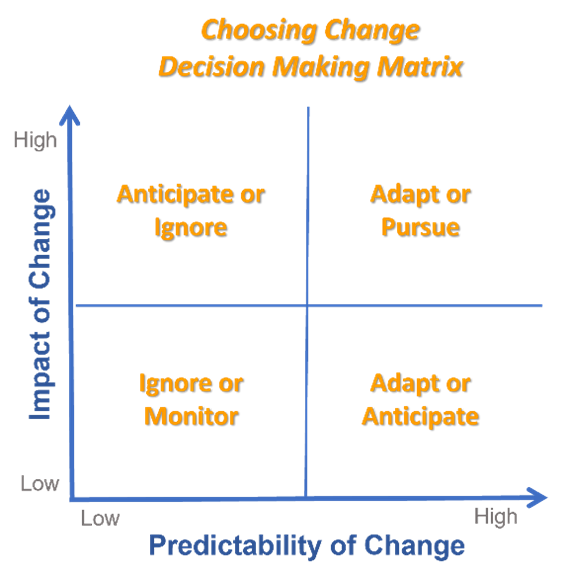Albert Einstein’s Special Theory of Relativity states that time is relative, and that its rate of passage depends on our frame of reference. Perhaps this explains why from September 2022 to March 2023 feels like a long time between Parts I and II of an article on choosing change versus chasing it.
In case you missed Part I, the summary goes like this: “The difference between winning and losing for an organization is how quickly and successfully its people recognize and choose an approach to change that enables them to flourish … and then work like crazy to ensure that happens.
To continue the Einstein reference, that sounds relatively easy. It isn’t. Making faster, better change choices requires us to regularly think about potential potential changes lurking over the horizon and then determine how we are going to respond to them.
Two Challenges of Change
1. Thinking about and planning for the future takes time, and most of us don’t effectively use it.How much time do you devote to actively thinking about the future and the changes that it could bring? For the average manager, it is about 25 minutes per day according to the Center for Management and Organization Effectiveness. That is just over two hours per week if you work five full days. For those of us who put in six, the number goes to 2.5 hours.
That’s not much, especially when you consider that the experts recommend that leaders devote 20 to 40 percent of their time on the future of their business.
Even that pales in comparison to Warren Buffet. He reportedly spends 80 percent of his time reading and thinking about the future.
2. We limit our options for change.When I got married, my wife said to me, “Randy, I’ll never ask you to change. I do, however, expect that you will continually adapt.” Unfortunately, that is how most of us look at change. Our iceberg must be melting, or our cheese has to be moving before we take action.
Choosing change means that we use all our options. Sure, we can adapt, but we can also:
- Anticipate change and create contingencies based on what might or might not happen.
- Pursue change that provides us an advantage.
- Ignore change that is extraneous noise that serves no purpose.
Again, Mr. Buffet provides excellent guidance: “The difference between successful people and really successful people is that really successful people say ‘No’ to almost everything.”
|
Related article: Choosing Change Part I: The Essential Ingredient to Winning By Randy Pennington |
Three Solutions
Making better, faster change decisions takes intention combined with diverse ways of analyzing our options. Here are three ideas to help.
1. Scout the future. I introduced the concept of scouting the future in Choosing Change Part I. The idea is based on the scouts who rode with the wagon trains headed westward across the United States after the Civil War. Every day these individuals rode out over the horizon to find the best route to their destination. More importantly, they were constantly on the lookout for water (opportunity) and hostiles (threats).In the world of business technology, there are two ways this can work:
- Dedicated Scout Team: The CIO of a higher education client of mine has established a cross-functional team to regularly scout for opportunities and threats. Membership is by application, and the members devote an average of four hours per week to scouting. The team provides regular reports to the CIO along with recommendations for changes.
The only criteria are that the opportunity or threat had to be based on something that was likely to happen or could generate a strategic advantage, AND the team has to recommend how the change could be incorporated into the daily operation.
Team members operate on a six-month rotating schedule with an option to renew for a full year if everyone thought it was a good idea. The Scout Team serves as a forum for vetting new ideas and identifying up-and-coming talent. - Dedicated Scouting Outings: Don’t have the resources for a dedicated Scout Team? Consider dedicated Scouting Outings instead. Team meetings devoted to thinking about the future—rather than your existing projects—work well on a quarterly basis. You can even divide the group into teams (much like a hackathon) to foster some friendly competition. All it takes is a few basic guidelines around identifying new opportunities or avoiding threats to the operation.
2. Ask better questions about the future. What will your industry look like in ten years? We all have an idea, but none of us knows for sure. Chances are, it will be much different than we think.
As Bill Gates said, “We always overestimate the change that will occur in the next two years and underestimate the change that will occur in the next ten.”
The quality of the answers we receive in our lives is in direct proportion to the quality of the questions we ask, and we can make better choices when we ask these questions:
- What are the assumptions on which your view of the future is based? What makes you believe that they are true?
- What would be the opposite of those assumptions? How would you adapt if those turned out to be more accurate?
- What must go absolutely right for your vision of the future to happen?
- What can’t go wrong for your vision to come to life?
- What do your answers mean for the changes you will anticipate, pursue, and ignore?
3. Prioritize change based on probability and impact. Increased understanding of assumptions and options prepares us to determine our choices around change.
Placing planned and potential change in the following matrix allows us to make more intentional choices.

Remember this: Good organizations change when they have to. The best organizations change when they choose to. The key is to be intentional in your move from chasing change to choosing change.

Written by Randy Pennington
Randy Pennington helps leaders deliver positive results in a world of accelerating change. He is a highly sought after resource for helping organizations prepare for their New Next™, and the author of several books, including Make Change Work.



